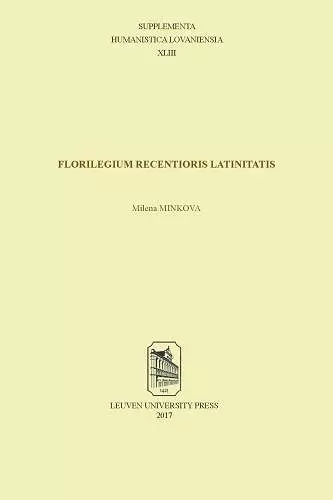Florilegium recentioris Latinitatis
Format:Paperback
Publisher:Leuven University Press
Published:15th Dec '17
Currently unavailable, and unfortunately no date known when it will be back

Neo-Latin, a truly interdisciplinary and multicultural field of study, has become especially relevant in today's global age. Latin does not belong to any particular country, but to the Republic of Letters with its high aims and universal appeal. A comprehensive critical anthology of Neo-Latin would thus be useful in the classroom, both in secondary school and on university level, as well as for independent scholars. The present volume is comprised of about fifty texts pertaining to geographical areas all around the world, spanning the 14th to the 20th centuries, written in a wide range of genres by authors of varied backgrounds, and touching on topics of dramatic importance for today. The language of the anthology is Latin, in accordance with the universality it aims to represent by its selection of texts.
As a whole, Minkova’s anthology provides a useful collection of influential and fascinating Neo-Latin texts, both known, authoritative works as well as obscurer examples, reflecting the variety of this literature. This volume will be useful to any teacher preparing a class on Neo-Latin texts. But the readership will presumably be wider. The inclusion of important authorities such as Petrarch, Thomas More, and Erasmus provides interesting glimpses into a huge, still widely obscure corpus for scholars of the Renaissance and early modern world from a variety of fields—history, philosophy, the modern philologies, etc. One can only hope that the language of the edition will not only attract lovers of the Latin language, but also not deter interested groups from neighboring fields.
Johanna Luggin, Renaissance Quarterly, Volume 73, Issue 1, Spring 2020, https://doi.org/10.1017/rqx.2019.498
It sustains the continuous tradition of Neo-Latin culture even in the twenty-first century, aims at being instructive to students and at cultivating those admirers of Latin who still revere classical Latin as a transnational communication tool of educated elites.
Josef Förster, Listy filologické / Folia philologica CXLII, 2019, 1–2
Anyone who wants to teach a survey course in Neo-Latin will find more here than he or she can possibly get through in a semester, and both the compiler and the publisher deserve our thanks for creating an alternative to the course packet compiled in haste, and in violation of copyright laws, that has served as a textbook in this field for most of us.
Craig Kallendorf, The Neo-Latin News Vol. 66, Nos. 3&4
If we expand our canon to make room for the authors included in this anthology, then students, scholars, and lovers of Latin everywhere will find an array of new texts and voices to inspire them.
Michael Fontaine, Bryn Mawr Classical Review 2018.11.38 - http://www.bmcreview.org/2018/11/20181138.html
Minkova’s Florilegium is a book that has been sorely needed, and it is a rich addition to a field almost destitute of teaching resources.
Tom Hendrickson, M In Medias Res, October 23, 2018
ISBN: 9789462701250
Dimensions: unknown
Weight: unknown
300 pages